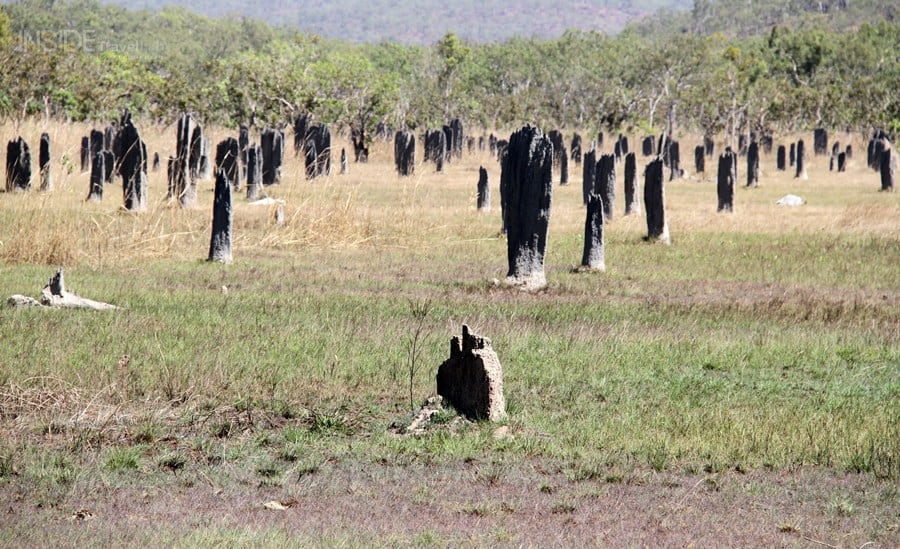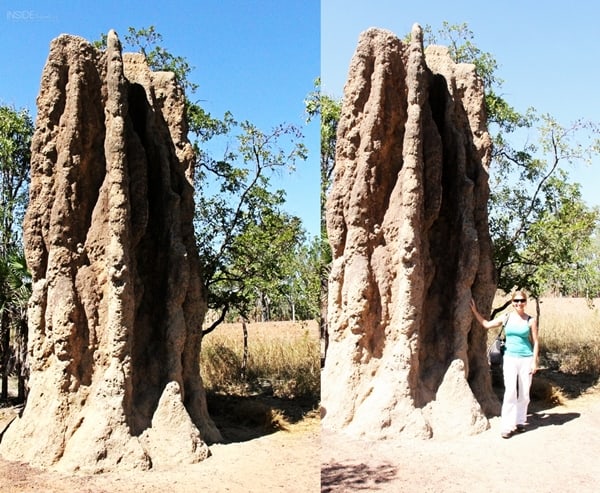The magnetic termite mounds in Australia attract visitors from all over the world. But what are these fascinating structures? And can they really be magnetic?

Magnetic Termite Mounds in Australia
Let’s face it, the words magnetic termite mounds don’t sound all that appealing.
“Magnetic” speaks of mystery, magic and heart fluttering chemistry. “Termites,” meanwhile, tell tales of corrosion, erosion and an itchy sense of unease at the sound of scuttling in the night. And then there’s “mound,” which barely bothers to register as a word in its own right at all.
Magnetic termite mounds. This unlikely trio of words bounced around my head on the drive to Litchfield Park in Australia’s Northern Territory.
I didn’t feel terribly excited.
But there they were on every road sign: magnetic termite mounds, magnetic wormite clowns, magnetic marmite crowns…
You have to understand, I was jetlagged and tired. And I didn’t really know what they were.
What Are Magnetic Termite Mounds?
Structures built by small insects that rise up to two metres and beyond in Australia’s natural parks.

Driving To Litchfield Park to Find the Termite Mounds
The earth turned rust red while the sky scratched deep into the blue pools in my eyes. Grass scrubbed the land and burning dust scrubbed my lungs.
I walked from the car and followed the voices. Children, adults, bloggers, guides. All dwarf-like amid house-high cartoon like mounds.
Termite mounds.
Yes, termite mounds. Solid, towering termite mounds.
But they weren’t the ones I was after. For while they were indeed termite mounds, they were not magnetic.
Nor, it turns out disappointingly, are the ones that carry the name.
When I found them, these slender grey tombstones that rise from the earth, my buzzing mental chatter fell quiet.

Nature’s Stonehenge
One after the other, knife edge to knife edge, flat shadow to flat shadow, they stretched across the ground, a graveyard of military ghosts. No wonder those early explorers called them magnetic, a field of upright needles aligned along a meridian of the sun.
But, as it turns out, magnets and magnetism have nothing to do with it. This arrangement is nature’s answer to the problem of termite air conditioning. By aligning themselves with the journey of the sun, these termites ensure that the temperature stays even over the course of the ferociously hot day and subsequent cold night.
Captivating. Beautiful. Cool. Dry
The words wriggled and raced no more. Instead, they fell into formation and fell into sense.
Magnetic termite mounds. If you’ll forgive me, they are among nature’s greatest attractions.

How to See Magnetic Termite Mounds in Australia
Litchfield Park
Beautiful Litchfield National Park lives within a short drive from Darwin in the Norther Territory.
Kakadu National Park
The stunning Kakadu National Park is a little further from Darwin and really merits an overnight stay. Read about the other things to see and do in Kakadu National Park here.





Oh, I love your description of the termite mounts. Yes, “mount” doesn’t cover it quite and I had the same tomb stone impression!
Did you go to the river? I forgot the name of the place, but locals use it for cooling down in the wet…
I went to plenty of rockpools surrounded by waterfalls. Cool and beautiful…until I saw the signs saying that crocodiles only swam there at particular times of year!
I never knew termite mounds will looked awesome when they are standing together. I was fascinated by this.
Me neither – a wonderful find.
These are extraordinary! Nature’s Stonehenge. Yet, these Magnetic Termite Mounds also resemble Native American totem poles. I can almost make out face shapes in the ridges. Truly remarkable. Thanks for sharing this amazing bit of nature.
Ooh yes, I like that description. Nature’s Stonehenge – spot on!